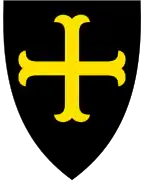Torsken Municipality
Torsken kommune Doaskku suohkan | |
|---|---|
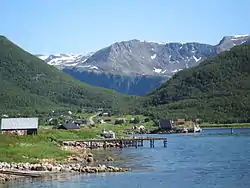 View of Medby in Torsken | |
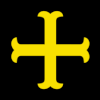 Flag | |
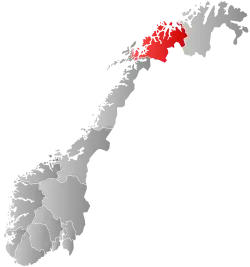 Troms within Norway | |
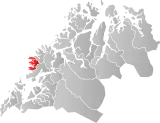 Torsken within Troms | |
| Coordinates: 69°17′47″N 17°02′11″E / 69.29639°N 17.03639°E | |
| Country | Norway |
| County | Troms |
| District | Midt-Troms |
| Established | 1 Jan 1902 |
| • Preceded by | Berg Municipality |
| Disestablished | 1 Jan 2020 |
| • Succeeded by | Senja Municipality |
| Administrative centre | Gryllefjord |
| Area (upon dissolution) | |
| • Total | 243.42 km2 (93.98 sq mi) |
| • Land | 235.30 km2 (90.85 sq mi) |
| • Water | 8.12 km2 (3.14 sq mi) 3.3% |
| • Rank | #310 in Norway |
| Population (2018) | |
| • Total | 943 |
| • Rank | #401 in Norway |
| • Density | 4/km2 (10/sq mi) |
| • Change (10 years) | |
| Demonym | Torskeværing[1] |
| Official language | |
| • Norwegian form | Bokmål |
| Time zone | UTC+01:00 (CET) |
| • Summer (DST) | UTC+02:00 (CEST) |
| ISO 3166 code | NO-1928[3] |
Torsken is a former municipality that was located on the western coast of the large island of Senja in the old Troms county, Norway. The municipality existed from 1902 until its dissolution in 2020 when it was merged into the new Senja Municipality. The administrative centre of the municipality was the village of Gryllefjord. Other larger villages in Torsken municipality included the villages of Torsken, Medby, and Flakstadvåg.
The historic Torsken Church in the village of Torsken dates back to the 18th century. Ånderdalen National Park was partially located inside the old borders of Torsken and neighboring Tranøy municipalities.
At the time of its dissolution as a municipality on 1 January 2020, the 243-square-kilometre (94 sq mi) municipality was the 310th largest by area out of the 422 municipalities in Norway. Torsken was also the 401st most populous municipality in Norway with a population of 943. The municipality's population density was 4 inhabitants per square kilometre (10/sq mi) and its population has decreased by 0.6% over the previous decade.[4][5]
General information
The municipality of Torsken was established on 1 January 1902 when it was separated from the municipality of Berg. The initial population of Torsken was 1,229. During the 1960s, there were many municipal mergers across Norway due to the work of the Schei Committee. On 1 January 1964, the Rødsand area of Torsken (population: 160) was transferred to the neighboring Tranøy Municipality.[6]
In March 2017, the Parliament of Norway voted to merge the municipalities of Berg, Torsken, Lenvik, and Tranøy. The new municipality would encompass the whole island of Senja plus part of the mainland located between the Gisundet strait and the Malangen fjord. On 1 January 2020, Torsken municipality ceased to exist when it became part of the new Senja Municipality.[7][8]
Name
The municipality (originally the parish) is named after the old Torsken farm (Old Norse: Þoskar) since the first Torsken Church was built there. The farm (and municipal) name were taken from the nearby mountain, Torsken. The name comes from the word þorskr which means "cod". (Several mountains in Norway are named after their likeness with a fish.)[9]
Coat of arms
The coat of arms was granted on 23 March 1990. The official blazon is "Sable, a cross moline Or" (Norwegian: I svart et gull ankerkors). This means the arms have a black field (background) and the charge is a cross moline (Norwegian: ankerkors; lit. 'anchor cross'). The cross moline has a tincture of Or which means it is commonly colored yellow, but if it is made out of metal, then gold is used. The cross is a symbol for both Christianity and the importance of the local harbor. The economy of Torsken is largely dependent on its harbors and an anchor cross is an appropriate symbol. The arms were designed by Ivar Enoksen.[10][11][12]
Churches
The Church of Norway had one parish (sokn) within the municipality of Torsken. It was part of the Senja prosti (deanery) in the Diocese of Nord-Hålogaland.
| Parish (sokn) | Church name | Location of the church | Year built |
|---|---|---|---|
| Torsken | Torsken Church | Torsken | 1784 |
| Flakkstadvåg Chapel | Flakstadvåg | 1925 | |
| Gryllefjord Chapel | Gryllefjord | 1902 | |
| Medby Chapel | Medby | 1890 |
Economy

Most of the inhabitants lived in the fishing village of Gryllefjord in the northern part of the municipality. The second most important village was Torsken, only a few kilometers to the south. Kaldfarnes/Medby, Grunnfarnes, and Flakstadvåg were other fishing villages further south. The municipality was close to the resources of the major fishing grounds off the Vesterålen archipelago, and 2004 landed 9.8 million tons of fish with a value of 76.3 million kr for fish-processing in Torsken, Gryllefjord, Kaldfarnes, and Grunnfarnes. Most people worked in the fields of fishing or fish processing.
The municipality had few productive forests, but there were some spruce trees planted in sheltered areas. In the southern parts of Torsken there was some usable farmland. There were five farms with more than 5 decares (0.0050 km2; 0.0019 sq mi) of agricultural land in the entire municipality (as of 1999).[13]
Transportation

The Andenes–Gryllefjord Ferry that went across the Andfjorden to Andenes on the island of Andøya was operated during about two months each summer. The road from the northern part of the municipality to Kaldfarnes, Grunnfarnes, and Flakstadvåg was far from direct. One had to drive north and then east to Berg and then south to Tranøy before turning northwest and returning to Torsken. These were the only road connections from the rest of Norway to Torsken.
Government
While it existed, this municipality was responsible for primary education (through 10th grade), outpatient health services, senior citizen services, unemployment, social services, zoning, economic development, and municipal roads. During its existence, this municipality was governed by a municipal council of directly elected representatives. The mayor was indirectly elected by a vote of the municipal council.[14] The municipality fell under the Senja District Court and the Hålogaland Court of Appeal.
Municipal council
The municipal council (Kommunestyre) of Torsken was made up of 15 representatives that were elected to four year terms. The party breakdown of the final municipal council was as follows:
| Party name (in Norwegian) | Number of representatives | |
|---|---|---|
| Labour Party (Arbeiderpartiet) | 9 | |
| Centre Party (Senterpartiet) | 6 | |
| Total number of members: | 15 | |
| Party name (in Norwegian) | Number of representatives | |
|---|---|---|
| Labour Party (Arbeiderpartiet) | 7 | |
| Coastal Party (Kystpartiet) | 4 | |
| Centre Party (Senterpartiet) | 4 | |
| Total number of members: | 15 | |
| Party name (in Norwegian) | Number of representatives | |
|---|---|---|
| Labour Party (Arbeiderpartiet) | 3 | |
| Conservative Party (Høyre) | 1 | |
| Coastal Party (Kystpartiet) | 2 | |
| Centre Party (Senterpartiet) | 4 | |
| Common list in Torsken (Felleslista i Torsken) | 1 | |
| Gryllefjord local list (Gryllefjord bygdeliste) | 4 | |
| Total number of members: | 15 | |
| Party name (in Norwegian) | Number of representatives | |
|---|---|---|
| Labour Party (Arbeiderpartiet) | 2 | |
| Progress Party (Fremskrittspartiet) | 1 | |
| Coastal Party (Kystpartiet) | 1 | |
| Joint list of the Centre Party and free voters (Senterpartiet og frie velgeres liste) |
5 | |
| Common list in Torsken (Felleslista i Torsken) | 2 | |
| Gryllefjord local list (Gryllefjord bygdeliste) | 4 | |
| Total number of members: | 15 | |
| Party name (in Norwegian) | Number of representatives | |
|---|---|---|
| Labour Party (Arbeiderpartiet) | 5 | |
| Centre Party (Senterpartiet) | 6 | |
| Common list (Felleslista) | 5 | |
| Gryllefjord local list (Gryllefjord bygdeliste) | 3 | |
| Total number of members: | 19 | |
| Party name (in Norwegian) | Number of representatives | |
|---|---|---|
| Labour Party (Arbeiderpartiet) | 3 | |
| Centre Party (Senterpartiet) | 7 | |
| Common list (Felleslista) | 4 | |
| Gryllefjord local list (Gryllefjord bygdeliste) | 5 | |
| Total number of members: | 19 | |
| Party name (in Norwegian) | Number of representatives | |
|---|---|---|
| Labour Party (Arbeiderpartiet) | 5 | |
| Socialist Left Party (Sosialistisk Venstreparti) | 1 | |
| Common list (Felleslista) | 13 | |
| Total number of members: | 19 | |
| Party name (in Norwegian) | Number of representatives | |
|---|---|---|
| Labour Party (Arbeiderpartiet) | 8 | |
| Conservative Party (Høyre) | 2 | |
| Christian Democratic Party (Kristelig Folkeparti) | 1 | |
| Centre Party (Senterpartiet) | 2 | |
| Torsken social democrat common list (Torsken sosialdemokratisk fellesliste) | 6 | |
| Total number of members: | 19 | |
| Party name (in Norwegian) | Number of representatives | |
|---|---|---|
| Labour Party (Arbeiderpartiet) | 10 | |
| Conservative Party (Høyre) | 2 | |
| Christian Democratic Party (Kristelig Folkeparti) | 2 | |
| Centre Party (Senterpartiet) | 1 | |
| Torsken non-party list (Torsken upolitiske liste) | 3 | |
| Grunnfarnes common list (Grunnfarnes Felleslista) | 1 | |
| Total number of members: | 19 | |
| Party name (in Norwegian) | Number of representatives | |
|---|---|---|
| Labour Party (Arbeiderpartiet) | 7 | |
| Conservative Party (Høyre) | 4 | |
| Christian Democratic Party (Kristelig Folkeparti) | 2 | |
| Centre Party (Senterpartiet) | 3 | |
| Torsken non-party list (Torsken upolitiske liste) | 3 | |
| Total number of members: | 19 | |
| Party name (in Norwegian) | Number of representatives | |
|---|---|---|
| Labour Party (Arbeiderpartiet) | 7 | |
| Christian Democratic Party (Kristelig Folkeparti) | 4 | |
| Torsken non-party list (Torsken Upolitiske Liste) | 3 | |
| Midtbygda non-party list (Midtbygda Upolitiske Liste) | 5 | |
| Total number of members: | 19 | |
| Party name (in Norwegian) | Number of representatives | |
|---|---|---|
| Labour Party (Arbeiderpartiet) | 6 | |
| Joint List(s) of Non-Socialist Parties (Borgerlige Felleslister) | 2 | |
| Local List(s) (Lokale lister) | 11 | |
| Total number of members: | 19 | |
| Party name (in Norwegian) | Number of representatives | |
|---|---|---|
| Labour Party (Arbeiderpartiet) | 7 | |
| Local List(s) (Lokale lister) | 12 | |
| Total number of members: | 19 | |
| Party name (in Norwegian) | Number of representatives | |
|---|---|---|
| Labour Party (Arbeiderpartiet) | 7 | |
| Joint List(s) of Non-Socialist Parties (Borgerlige Felleslister) | 4 | |
| Local List(s) (Lokale lister) | 4 | |
| Total number of members: | 15 | |
| Party name (in Norwegian) | Number of representatives | |
|---|---|---|
| Labour Party (Arbeiderpartiet) | 4 | |
| Local List(s) (Lokale lister) | 11 | |
| Total number of members: | 15 | |
| Party name (in Norwegian) | Number of representatives | |
|---|---|---|
| Labour Party (Arbeiderpartiet) | 6 | |
| Joint List(s) of Non-Socialist Parties (Borgerlige Felleslister) | 2 | |
| Local List(s) (Lokale lister) | 7 | |
| Total number of members: | 15 | |
| Party name (in Norwegian) | Number of representatives | |
|---|---|---|
| Labour Party (Arbeiderpartiet) | 6 | |
| Conservative Party (Høyre) | 2 | |
| Local List(s) (Lokale lister) | 4 | |
| Total number of members: | 12 | |
| Party name (in Norwegian) | Number of representatives | |
|---|---|---|
| Labour Party (Arbeiderpartiet) | 4 | |
| Christian Democratic Party (Kristelig Folkeparti) | 1 | |
| Joint List(s) of Non-Socialist Parties (Borgerlige Felleslister) | 4 | |
| Local List(s) (Lokale lister) | 3 | |
| Total number of members: | 12 | |
| Party name (in Norwegian) | Number of representatives | |
|---|---|---|
| Labour Party (Arbeiderpartiet) | 4 | |
| Christian Democratic Party (Kristelig Folkeparti) | 2 | |
| List of workers, fishermen, and small farmholders (Arbeidere, fiskere, småbrukere liste) | 2 | |
| Joint List(s) of Non-Socialist Parties (Borgerlige Felleslister) | 4 | |
| Total number of members: | 12 | |
| Party name (in Norwegian) | Number of representatives | |
|---|---|---|
| Labour Party (Arbeiderpartiet) | 5 | |
| Joint List(s) of Non-Socialist Parties (Borgerlige Felleslister) | 5 | |
| Local List(s) (Lokale lister) | 2 | |
| Total number of members: | 12 | |
| Note: Due to the German occupation of Norway during World War II, no elections were held for new municipal councils until after the war ended in 1945. | ||
Mayors
The mayors of Torsken (incomplete list):
Geography
Torsken was a rugged area on the west coast of the island of Senja. Many different fjords cut into its mountainous coastline including Sifjorden, Selfjorden, Torskefjorden, Gryllefjorden, and Skipsfjorden. Between mountain peaks that ranged from 600 to 1,000 metres (2,000 to 3,300 ft), there were deep valleys and narrow depressions. Many of the valleys contained marshes or lakes. The bedrock under Torsken consisted mostly of gneiss and granite.[13]
Climate
| Climate data for Gryllefjord, Torsken | |||||||||||||
|---|---|---|---|---|---|---|---|---|---|---|---|---|---|
| Month | Jan | Feb | Mar | Apr | May | Jun | Jul | Aug | Sep | Oct | Nov | Dec | Year |
| Daily mean °C (°F) | −2.5 (27.5) |
−2.5 (27.5) |
−1.4 (29.5) |
1.3 (34.3) |
5.4 (41.7) |
9.0 (48.2) |
11.5 (52.7) |
11.3 (52.3) |
7.8 (46.0) |
4.1 (39.4) |
0.6 (33.1) |
−1.6 (29.1) |
3.6 (38.5) |
| Average precipitation mm (inches) | 107 (4.2) |
93 (3.7) |
87 (3.4) |
76 (3.0) |
55 (2.2) |
67 (2.6) |
77 (3.0) |
91 (3.6) |
114 (4.5) |
150 (5.9) |
128 (5.0) |
130 (5.1) |
1,175 (46.3) |
| Source: Norwegian Meteorological Institute[32] | |||||||||||||
See also
References
- ↑ "Navn på steder og personer: Innbyggjarnamn" (in Norwegian). Språkrådet.
- ↑ "Forskrift om målvedtak i kommunar og fylkeskommunar" (in Norwegian). Lovdata.no.
- ↑ Bolstad, Erik; Thorsnæs, Geir, eds. (26 January 2023). "Kommunenummer". Store norske leksikon (in Norwegian). Kunnskapsforlaget.
- ↑ Statistisk sentralbyrå (2018). "Table: 06913: Population 1 January and population changes during the calendar year (M)" (in Norwegian). Retrieved 10 December 2018.
- ↑ Statistisk sentralbyrå. "09280: Area of land and fresh water (km²) (M)" (in Norwegian). Retrieved 10 December 2018.
- ↑ Jukvam, Dag (1999). Historisk oversikt over endringer i kommune- og fylkesinndelingen (PDF) (in Norwegian). Statistisk sentralbyrå. ISBN 9788253746845.
- ↑ "Senja kommune 2020" (in Norwegian). Retrieved 9 September 2017.
- ↑ Vermes, Thomas (29 March 2017). "Stortingsflertallet gjør fire Senja-kommuner til én". ABC Nyheter (in Norwegian). Retrieved 9 September 2017.
- ↑ Rygh, Oluf (1911). Norske gaardnavne: Tromsø amt (in Norwegian) (17 ed.). Kristiania, Norge: W. C. Fabritius & sønners bogtrikkeri. p. 77.
- ↑ "Civic heraldry of Norway - Norske Kommunevåpen". Heraldry of the World. Retrieved 29 January 2023.
- ↑ "Torsken, Troms (Norway)". Flags of the World. Retrieved 29 January 2023.
- ↑ "Godkjenning av våpen og flagg". Lovdata.no (in Norwegian). Norges kommunal- og arbeidsdepartementet. 30 May 1990. Retrieved 29 January 2023.
- 1 2 Store norske leksikon. "Torsken" (in Norwegian). Retrieved 3 December 2012.
- ↑ Hansen, Tore; Vabo, Signy Irene, eds. (20 September 2022). "kommunestyre". Store norske leksikon (in Norwegian). Kunnskapsforlaget. Retrieved 1 January 2023.
- 1 2 3 4 "Table: 04813: Members of the local councils, by party/electoral list at the Municipal Council election (M)" (in Norwegian). Statistics Norway.
- ↑ "Tall for Norge: Kommunestyrevalg 2011 - Troms Romsa". Valg Direktoratet. Retrieved 26 October 2019.
- ↑ "Kommunestyrevalget 1995" (PDF) (in Norwegian). Oslo-Kongsvinger: Statistisk sentralbyrå. 1996. Retrieved 18 March 2020.
- ↑ "Kommunestyrevalget 1991" (PDF) (in Norwegian). Oslo-Kongsvinger: Statistisk sentralbyrå. 1993. Retrieved 18 March 2020.
- ↑ "Kommunestyrevalget 1987" (PDF) (in Norwegian). Oslo-Kongsvinger: Statistisk sentralbyrå. 1988. Retrieved 18 March 2020.
- ↑ "Kommunestyrevalget 1983" (PDF) (in Norwegian). Oslo-Kongsvinger: Statistisk sentralbyrå. 1984. Retrieved 18 March 2020.
- ↑ "Kommunestyrevalget 1979" (PDF) (in Norwegian). Oslo: Statistisk sentralbyrå. 1979. Retrieved 18 March 2020.
- ↑ "Kommunevalgene 1975" (PDF) (in Norwegian). Oslo: Statistisk sentralbyrå. 1977. Retrieved 18 March 2020.
- ↑ "Kommunevalgene 1972" (PDF) (in Norwegian). Oslo: Statistisk sentralbyrå. 1973. Retrieved 18 March 2020.
- ↑ "Kommunevalgene 1967" (PDF) (in Norwegian). Oslo: Statistisk sentralbyrå. 1967. Retrieved 18 March 2020.
- ↑ "Kommunevalgene 1963" (PDF) (in Norwegian). Oslo: Statistisk sentralbyrå. 1964. Retrieved 18 March 2020.
- ↑ "Kommunevalgene og Ordførervalgene 1959" (PDF) (in Norwegian). Oslo: Statistisk sentralbyrå. 1960. Retrieved 18 March 2020.
- ↑ "Kommunevalgene og Ordførervalgene 1955" (PDF) (in Norwegian). Oslo: Statistisk sentralbyrå. 1957. Retrieved 18 March 2020.
- ↑ "Kommunevalgene og Ordførervalgene 1951" (PDF) (in Norwegian). Oslo: Statistisk sentralbyrå. 1952. Retrieved 18 March 2020.
- ↑ "Kommunevalgene og Ordførervalgene 1947" (PDF) (in Norwegian). Oslo: Statistisk sentralbyrå. 1948. Retrieved 18 March 2020.
- ↑ "Kommunevalgene og Ordførervalgene 1945" (PDF) (in Norwegian). Oslo: Statistisk sentralbyrå. 1947. Retrieved 18 March 2020.
- ↑ "Kommunevalgene og Ordførervalgene 1937" (PDF) (in Norwegian). Oslo: Statistisk sentralbyrå. 1938. Retrieved 18 March 2020.
- ↑ "eKlima Web Portal". Norwegian Meteorological Institute. Archived from the original on 14 June 2004.
External links
- Municipal fact sheet from Statistics Norway (in Norwegian)
